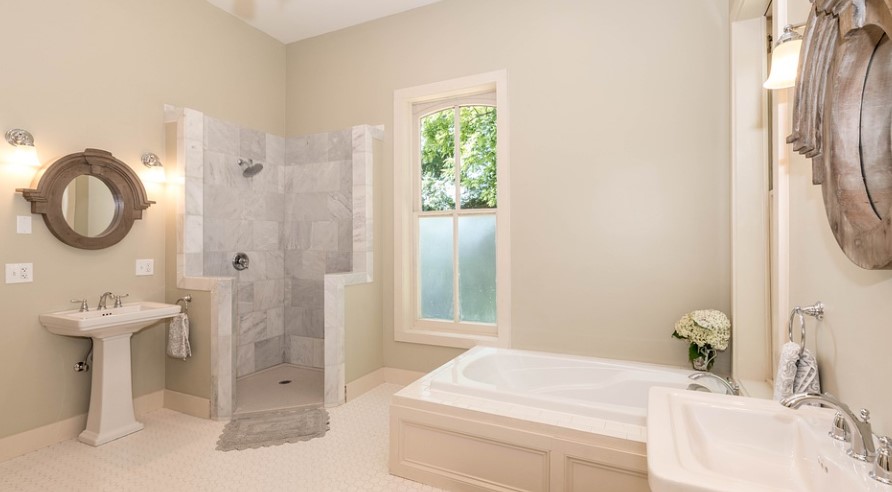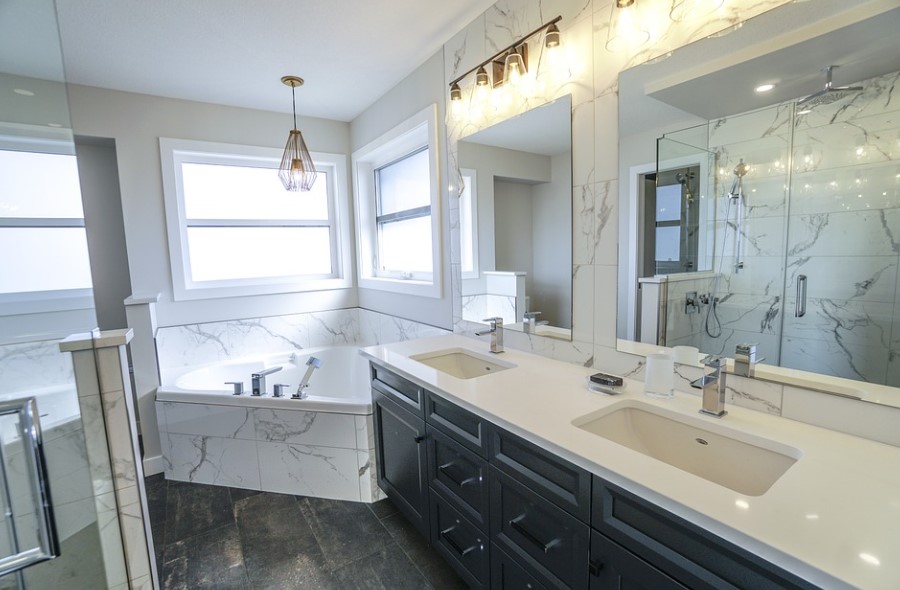Page Contents
Bathrooms that are Bright and Fresh
At the start and end of each day, a bathroom is a pleasant place to relax. Therefore, so it is worth investing some time in making it look and feel like a spa. Adding a comforting ambiance to an older bathroom is often as simple as making a few small changes.
Changing fabrics, towels, and tiles can help freshen up an outdated bathroom, as can replacing mirrors and lighting. Mildew damages a room’s appearance and can pose a health risk. Ventilation and hygiene should remain priorities.

Setting up the right environment
-
The right lighting for a relaxing bath can be created by using a soft bulb. Decorative candles can also add to the spa experience and provide flattering lighting for almost any complexion.
-
Make small bathrooms appear larger by painting them white, a pale blue color, or wood that is light in color. Light-colored accessories are an alternative to replacing tiles or repainting a room if you are unable to replace tiles.
-
Replace the shower partition with a modern one If you have an older bathroom, this works wonders because it doesn’t take much effort to do.
-
Clutter should be kept to a minimum: Only items that are regularly used should be displayed.
-
If you have limited space in your bathroom, store towels in a cupboard. Alternatively, roll them up, secure them with a ribbon, and place them standing up in a basket by the bathtub for a chic yet practical solution.
-
Bonsai trees and tropical plants thrive in humid environments, so a large bathroom is suitable for them. Make your relaxing area stylish and inviting by adding upholstered furniture. You can paint your toenails or moisturize your skin while sitting on stools with terry cloth seats.
-
Make your home smell soothing with aromatherapy candles, lotions, and diffusers that feature lavender, orange, and vanilla scents.
-
To stay on top of the time while getting ready, keeping a waterproof clock in the bathroom—one that can be attached to the tiles with suction cups is ideal.
-
Start your day with relaxing nature sounds by getting a waterproof music player.
Fabric and Fitting Harmonize with Older Tile
Fabrics of the highest quality
The right fabrics can transform the bathroom into a comfortable, attractive space. As well as being kind to the skin, they should also be effective.
Choosing a shower curtain that matches your other bathroom furnishings is imperative. Make sure your fabric curtains can be machine washed, as they are more chic and attractive than plastic ones, but they need to be cleaned regularly.
Make the bathroom look coordinated by choosing towels of different sizes. It will be a joy to dry off after a bath with thick, high-quality towels.
Tiles that pose a problem
In the event that your style is cramped by old, cracked tiles, graying grout, or 1970s decor, don’t begin demolition work right away. Recycle rather than discard by taking a cue from previous generations.
A thorough cleaning will inject new life into the existing tiles. You can remove stubborn stains with ammonia or alcohol mixed with water, and scale can be removed with vinegar mixed with water. Make old tiles shine again by rubbing linseed oil on them.
Use matching paint from an art supply store to repair small cracks in the tiles. Fill hairline cracks in tiles with a small amount of paint mixed with grout. Smooth it out.
Repaint older tiles’ grout to renew their appearance (special grout-coloring kits are available). Grout paint cannot be applied on tiles made of non-enamel or on top of a joint sealer that is water-resistant.
With adhesive mirror tiles, you can visually enlarge the bathroom. When old tiles cannot be replaced, they make a suitable alternative. To cover unwanted tiles, you can paint over them with tile primer and lacquer.
It is possible to restore unsalvageable existing tiles by applying a newly laid layer of tiles over them. Resurfacing the wall is more difficult and more expensive than removing the old layer.
Painting tile paint over tiles is even easier-but only if the tiles won’t get wet frequently.
Damaged tiles need to be replaced
A damp environment can exacerbate the problems caused by damaged tiles. The following steps should be followed as soon as possible if you find a cracked or chipped tile. You can use contrasting materials if you cannot match the tiles exactly.
1. By cutting diagonally through the tile with a dry-cut saw drill attachment or drilling several holes with a drill, you can remove the grout around the damaged tile.
2. With a flat chisel and hammer, chip off chunks of the tile until it comes loose. Make sure the old adhesive is removed as much as possible.
3. Use tile spacers to position and fit the replacement tile correctly after covering its back with bonding material.
4. Make sure the glue dries overnight (or according to the manufacturer’s instructions). Grout should then be applied, and the area should be cleaned afterward.

The threat of mildew
-
A proper air circulation system will keep mildew from taking hold by removing moisture. It is imperative to turn on the bathroom fan first, but here are a few other tips that may help.
-
As soon as you exit the shower, use a squeegee to wipe condensation off the shower wall and tiles.
-
Vinegar should be used regularly to clean the corners between the shower or bath and the tiled wall.
-
The ceiling and walls should be painted with mildew-resistant paint after they have been tilled.
-
The grout should be removed where mildew has developed, the edge should be cleaned thoroughly and new grout should be applied to the cleaned edges.